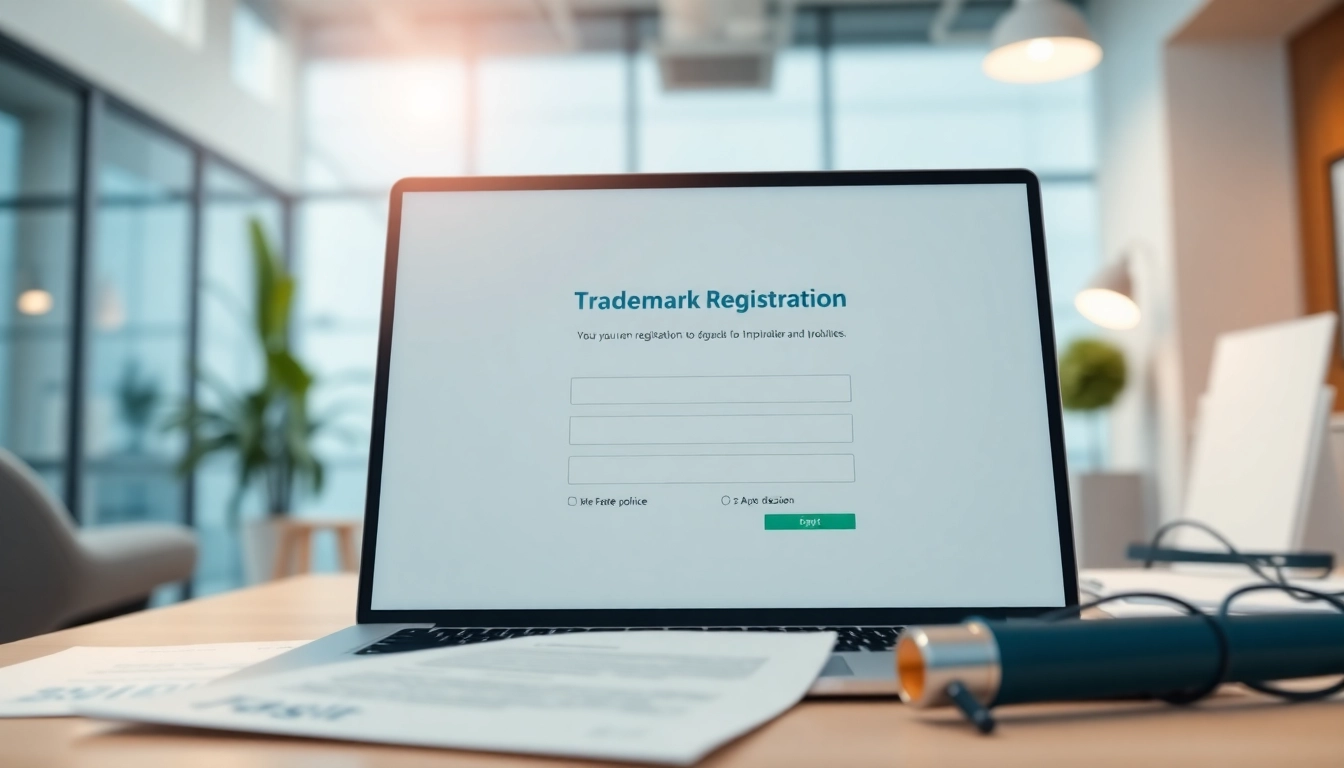
Understanding Online Trademark Registration Platforms
What is an Online Trademark Registration Platform?
An online trademark registration platform is a digital service that allows individuals and businesses to apply for, manage, and maintain their trademark rights over the internet. These platforms serve as intermediaries between the users and trademark offices, most notably the United States Patent and Trademark Office (USPTO). By utilizing these platforms, users can streamline the trademark application process, making it faster and more efficient than traditional methods, where paperwork often dominates. The advent of technology has transformed how trademarks are processed, resulting in easier navigation and improved accessibility for users across the globe.
Benefits of Using an Online Trademark Registration Platform
Utilizing an online trademark registration platform offers several significant benefits. Firstly, it simplifies the application process for users who may not be familiar with intellectual property laws. The platforms often provide user-friendly interfaces that guide applicants through each step of the registration process.
Another major advantage is the time efficiency; traditional registration can take several months, whereas online platforms can expedite this to a matter of weeks. Additionally, many of these services offer real-time monitoring of trademark status, enabling users to know exactly where they stand in the registration process.
Cost-effectiveness is also a key benefit. Online platforms often provide competitive pricing compared to hiring traditional legal representatives. For small businesses or startups with limited budgets, this affordability makes trademark registration more accessible. In summary, using an online trademark registration platform reduces complexity, saves time, and may lower costs for users, contributing to a smoother overall experience.
Common Features of Online Trademark Registration Platforms
Online trademark registration platforms typically include a range of features designed to assist users in trademark registration and management. Common features include:
- User Guidance: Step-by-step instructions that help users fill out applications correctly.
- Database Searches: Tools that allow users to search existing trademarks to avoid conflicts.
- Document Generation: Automatic creation of necessary application forms.
- Status Tracking: Real-time updates on the progress of trademark applications.
- Legal Resources: Access to educational materials and professional insights about trademarks.
- Customer Support: Assistance from legal experts to answer questions and provide guidance.
These features enhance the trademark registration experience, ensuring that applicants not only file correctly but also have access to critical information throughout the process.
Steps to Register Your Trademark Online
Preparing Your Trademark Application
The first step in registering your trademark online is preparation. This involves several key actions:
- Choose Your Trademark: Determine the name, logo, or phrase that you want to trademark. Ensure it is unique and not already in use within the same market sector to reduce the chance of rejection.
- Conduct a Trademark Search: Use the online platform’s search tools to check if existing trademarks might conflict with your desired trademark. Each platform typically offers a database search feature that simplifies this step.
- Specify Your Goods or Services: Clearly define what products or services your trademark will be associated with. The USPTO requires applicants to specify this in the application.
- Gather Relevant Documentation: Collect any documents that may be needed to support your application, such as logos, descriptions of your products or services, and evidence of use.
Filing Your Trademark Application Online
Once you have gathered all necessary information and conducted a thorough search, the next step is to file your application. Here’s how:
- Create an Account: If you’re using an online registration platform, create an account to begin the application process.
- Fill Out the Application: Follow the prompts provided by the platform to fill out the application. Be sure to double-check all information for accuracy.
- Submit Payment: Most online platforms will require a fee. This often depends on the type of trademark application you are submitting.
- Review and Confirm Submission: Before finalizing your submission, review all details and ensure compliance with the platform’s guidelines.
What to Expect After Filing
After filing your trademark application online, the waiting period begins. The timeline can vary significantly depending on several factors, including the trademark office’s workload and whether your application faces any opposition. Here’s what you can generally expect:
- Examination: A trademark examiner will review your application to ensure it meets all necessary requirements.
- Official Communication: If your application is approved, you will receive an official notice. If there are issues, you may receive an Office Action requesting clarification or amendments.
- Publication: Once approved, your trademark will be published in the Official Gazette, allowing others to oppose your trademark if they believe it conflicts with theirs.
- Registration: If no opposition arises, your trademark will eventually be registered, and you will receive a certificate of registration.
Comparing Online Trademark Registration Services
Top Competitors in the Market
There are numerous online trademark registration platforms available, each offering its unique features and services. Some leading players in the market include:
- Trademark Engine: Known for its straightforward registration process and competitive pricing, Trademark Engine provides users with step-by-step guidance and document generation.
- LegalZoom: Offers trademark registration along with legal advice, making it suitable for users who may require more comprehensive support.
- Trama TM: Focuses on simplicity and transparent pricing, attracting users looking for stress-free solutions.
- Trademark Angel: A cost-effective service that emphasizes a streamlined application process while providing valuable resources and support.
Evaluating Features and Pricing
When selecting an online trademark registration service, it is important to evaluate both features and pricing. Here are some key aspects to consider:
- Pricing Structures: Examine if they have flat fees, tiered pricing based on services, and additional costs for searches or extensions.
- Features: Compare the range of features, such as ease of use, search capabilities, customer service availability, and extra legal resources.
- User Feedback: Investigate reviews and testimonials from past users to gauge satisfaction and success rates.
- Success Rate: Look into statistics regarding how often applicants succeed in registering their trademarks through the platform.
Choosing the right platform depends on your personal or business needs, complexity of your trademark request, and financial considerations.
User Reviews and Success Rates
Exploring user reviews can provide insights into a service’s reliability and effectiveness. Many platforms showcase testimonials on their sites, but independent reviews on websites like Trustpilot or Google Reviews offer more objective perspectives. Key points to note include:
- Response Times: Review comments about how quickly support teams respond to inquiries.
- Ease of Use: Look for feedback on how intuitive the application process is.
- Customer Satisfaction: Identify patterns regarding user satisfaction, particularly concerning assistance during the registration process.
- Outcome Stories: Seek detailed accounts of users who successfully registered their trademarks versus those who faced challenges.
Challenges in Online Trademark Registration
Common Mistakes to Avoid
While the process might seem straightforward, several common mistakes can hinder successful registration. Some of the pitfalls include:
- Incomplete Applications: Failing to provide complete information or required documents can lead to application rejections.
- Use of Ineligible Trademarks: Not ensuring that the trademark is eligible for registration can expose applicants to unnecessary complications.
- Underestimating the Opposition Period: Neglecting to account for potential objections can lead to delays and additional costs.
By being aware of these common errors and taking preventive measures, applicants can achieve a smoother and more successful trademark registration experience.
Understanding Legal Implications
Trademark registration carries significant legal implications for businesses. It is essential for applicants to understand the following:
- Rights Granted: A registered trademark provides legal protection and exclusive rights to use the mark in commerce.
- Permanency: While trademarks can last indefinitely, they require renewal and active use. Failure to use or renew a trademark may result in losing rights.
- International Considerations: Trademarks are territorial. Companies planning to operate globally must research international trademark laws and consider filing in other jurisdictions.
With these points in mind, businesses can make informed decisions related to branding and trademark protection.
Dealing with Office Actions
An office action occurs when the examining attorney at the trademark office identifies issues with the trademark application. These can range from minor clerical mistakes to substantive legal objections. Here’s how to handle them:
- Review the Action Promptly: Don’t delay in addressing the issues raised in the office action. Most have deadlines that must be adhered to.
- Seek Professional Help if Necessary: If the issues seem complex, consulting a trademark attorney can be beneficial in crafting a sufficient response.
- Prepare a Response: Respond to each point raised in the office action carefully and provide any additional documents required.
Proper handling of office actions can lead to the successful approval of the trademark after initial refusals.
Maximizing the Benefits of Your Registered Trademark
Maintaining Your Trademark Registration
Once your trademark has been successfully registered, the work isn’t over. Maintenance is crucial to ensure the longevity and effectiveness of your registration. Here are critical steps:
- File Renewal Applications: Trademarks must be renewed periodically, typically every 10 years in the United States. Mark your calendar to avoid lapses.
- Use Your Trademark Regularly: Actively using your trademark in commerce helps reinforce your rights and prevents it from becoming abandoned.
- Monitor for Infringement: Periodically check the market for potential infringements to protect your brand’s integrity.
Monitoring and Protecting Your Trademark
Monitoring your trademark is an essential aspect of maintaining your brand identity. Implement proactive measures, such as:
- Alert Systems: Utilize monitoring services that alert you to potential infringement cases or similar trademarks that could confuse your consumers.
- Legal Enforcement: Be prepared to take action against infringements if necessary, including sending cease and desist letters or pursuing litigation.
- Regular Searches: Conduct regular searches through USPTO and other databases to stay ahead and reinforce your rights.
Leveraging Your Trademark for Brand Growth
A registered trademark not only protects your brand but can also be a powerful asset to fuel growth. Here are some ways to leverage it:
- Licensing Opportunities: Consider licensing your trademark to third parties, generating potential revenue without additional overheads.
- Building Brand Recognition: Use your trademark to build a strong brand presence that resonates with consumers, reinforcing trust and loyalty.
- Expanding Markets: With a registered trademark, you can confidently expand into new markets, knowing you have legal protection for your brand identity.
In conclusion, navigating the intricate landscape of online trademark registration platforms can be daunting. However, with the right knowledge and resources, businesses can effectively protect their intellectual property and leverage trademarks for sustained growth and success. Whether you’re a new startup or an established business, a thorough understanding of trademark registration and maintenance ensures your brand remains distinct and safeguarded in a competitive marketplace.




